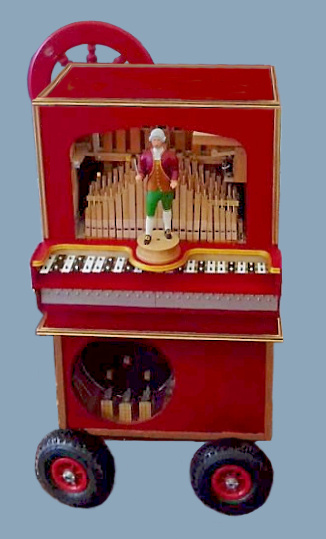 |
Street Organ |

The Barcelona Organ
This organ, now back in England after several years entertaining tourists and locals in Barcelona, is based on John Smith's popular "Topsy III" design. I made extensive modifications to the workings, however, which resulted in a much more versatile instrument. The following notes describe the Barcelona instrument, but prospective purchasers should note that street organs can be extensively customised. Please enquire if you have wild aspirations. The instrument has just over 100 pipes. There is a main rank of 43 stopped pipes, running from A# to a#'''. To keep the instrument compact, five of the bass notes in the full chromatic sequence are omitted (B, c#, f#, g#, b). This forces minor compromises in writing for the bass register, but it provides a very impressive 4-octave range in a small and relatively light instrument. Above b, it is fully chromatic. The top 23 pipes in the main rank (c'' to a#''') are considered the melody register. These pipes have a second identical rank, slightly detuned, to give the "celeste" effect which is characteristic of many street organs. This celeste rank can be muted, however, making the instrument sound very much like a baroque chamber organ. There is a set of 23 octave pipes matching the melody register (c''' to a#''''). These are open pipes, giving a delightfully shrill sound. On my modified design, they are not simply a stop added to the main melody pipes, but a completely independent register, which can play its own countermelodies. There is a countermelody register of 14 open pipes (e' to f'') - again, independent of the main rank. There is a removeable glockenspiel, which again matches the range of the main melody pipes (c'' to a#'''). On my design, this is also independent of the main rank, and can play simultaneous countermelodies. Percussion is provided by a snare drum (three beaters - centre and two sides), a triangle, and a wood block. 
Conductor
The melody and octave pipes have both a tremulant (the notes switch rapidly on and off) and a true vibrato, produced by a vibrato bellows which injects small pressure fluctuations into the windchest. Both these effects can be switched on and off by the controller. Vibrato rate is controllable from a dial on the main control panel. The air supply comes from a double-action bellows, which can be hand-cranked or driven from a large internal battery. This instrument has a conductor, controlled by a dedicated microcontroller. As far as I am aware, he is the only street organ conductor who conducts properly - i.e. he can move his baton both up and down and side to side. This allows him to conduct compound time signatures correctly - even 5/4 if required. His head turns, too. 
Control Panel
The playing mechanism is electromechanical. It uses the popular MIDI system. Tunes are written on a computer, using either a sequencer or score-writing software. The resulting MIDI file is transferred to an SD card, which is inserted into a MIDI decoder board on the main control panel. This converts MIDI notes into control signals to solenoids which work the pipes and the glockenspiel. It also allows specific notes to control percussion, tremulant, vibrato, celeste, and the conductor's movements. Producing tunes this way is very much quicker, easier and cheaper than the traditional pneumatic system using folded punched cards. Thousands of tunes can be held on a single tiny SD card. There are many tunes available on the Web as MIDI files, which can be adapted for the instrument. Decoration - the casework on this instrument is relatively plain. I am happy to quote for your preferred level of gaudy. Prices
Many modifications are possible. To order or discuss options, please contact me
VideoThe organ in action at a Dutch Queen's Day celebration. Teddy Bears' Picnic, with closeups of the visible mechanical bits working hard. A bit of complete lunacy - part of Stravinski's "Petrushka" played on the Barcelona organ. It merges into something less complex. | |||||
 More Instruments |
 Diabolus Homepage |
 Email for Diabolus |